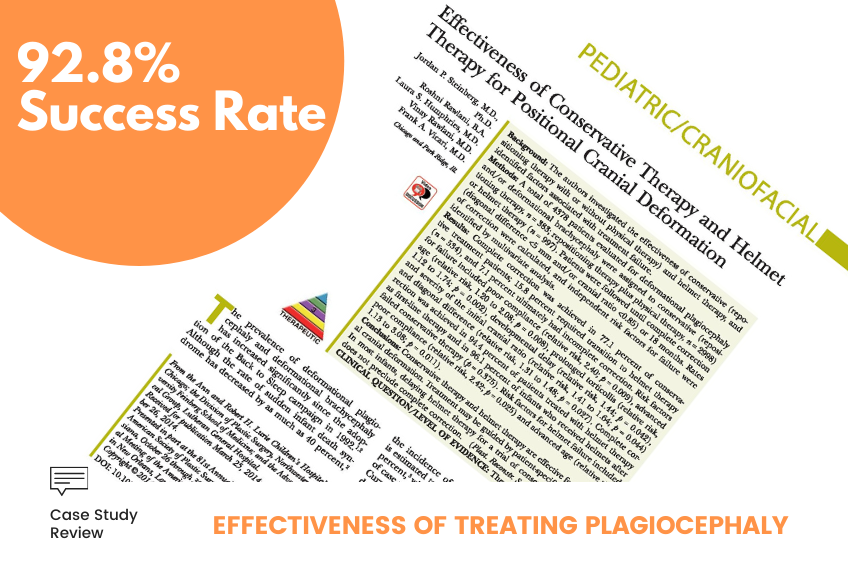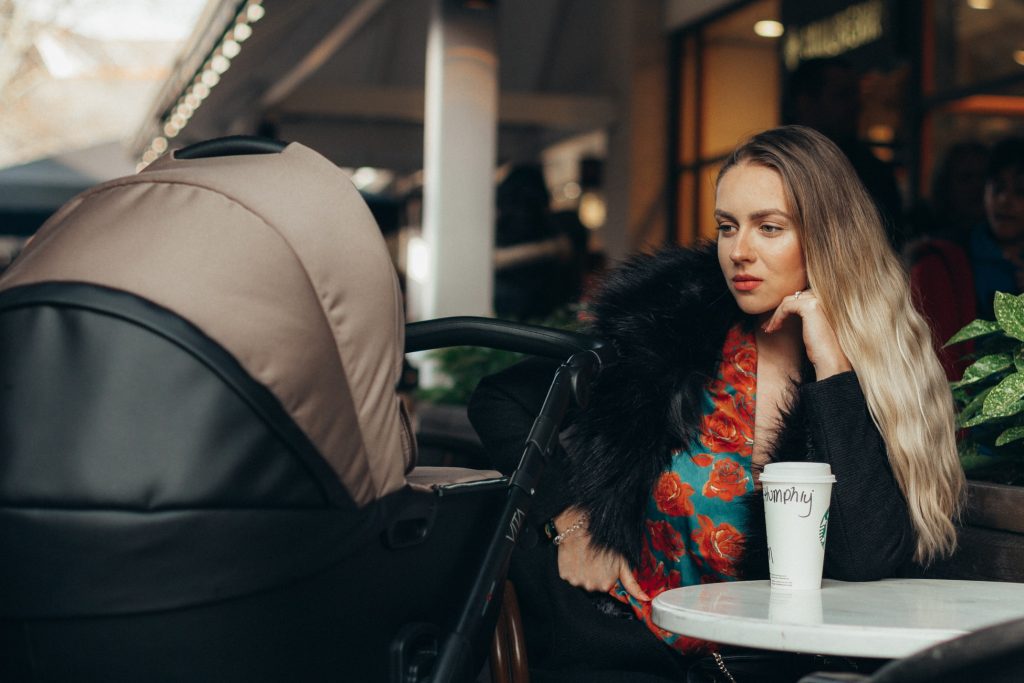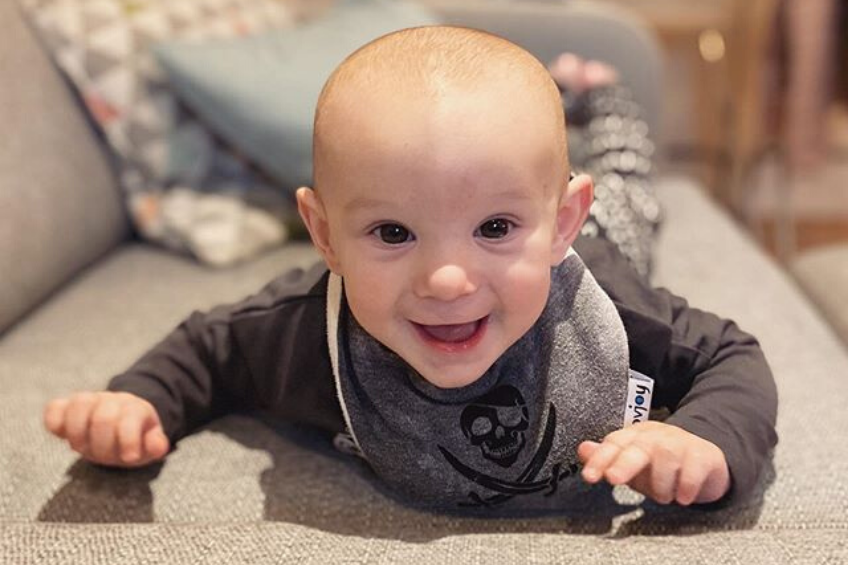90% Effective Rate When Treating Plagiocephaly Through Helmet or Manual Therapy.
/

Amy is a mother of an adorable three-month-old baby girl and follows all the books and latest blogs for new moms. She places her baby on her back when they sleeps and practices all the feeding and nap routines recommended for a newborn baby. One autumn morning, Amy notices that the baby’s head shape is not evenly distributed, making the back of the head look flat. She gives a call to her local pediatrician and she is recommended to use a memory foam pillow. The doctor hopes, that alleviating the pressure on the flat part of the head while sleeping, will eventually bring the baby’s head shape back to that of a symmetrical one.
After a few weeks, Amy notices no change, and begins to research topics related to “baby has flat back of head”. She identifies that her baby might have a condition called “plagiocephaly”. Amy reviews the options for treatment which include both helmet and manual therapy. However, she was never really into therapy, and begins to question if a plagiocephaly helmet will get her baby’s head shape back to normal.
This is the thought process going through many moms heads across America, as they investigate options for treating flat head baby syndrome. No one wants to take their baby to the park looking like a linebacker. It comes with questions from friends and family and everybody is not always equipped with the answers. Questions like “Is that helmet necessary?” or “Does the baby always have to wear a helmet?”. The topic is complex and we are going to layout the facts based on a case study titled, Effectiveness of Conservative Therapy and Helmet Therapy for Positional Cranial Deformation. The case study shows a clear and confident result of a greater than ninety percent success rate when treating a positional cranial deformation through helmet and manual therapy.

What stimulated this case study?
The Back to Sleep campaign in 1992, was an initiative backed by the US National Institute of Child Health and Human Development (NICHD). The NICHD found that babies who go to sleep on their stomachs, double their risks of dying from Sudden Infant Death Syndrome (SIDS). After 23 years since the Back to Sleep campaign was started, another condition has arisen, positional plagiocephaly or better known as flat head baby syndrome. The continuous pressure on the back of the baby’s head from going Back to Sleep, is beginning to cause slight head deformations. It has become such a problem, that researchers have recorded a whopping 600% increase in these types of head deformities. In addition, mothers are busier than ever, and babies are remaining in stationary environments which only worsens the problem.
Once it’s been determined that positional plagiocephaly exists, types of treatment include both helmet and manual therapies. The case study took place over the course of seven years, in which 5152 patients with flat head baby syndrome and/or deformational brachycephaly were treated with conservative or helmet therapy. Those whom overlooked the study which include, the Institutional Review Board of Children’s Memorial Hospital (presently Ann and Robert H. Lurie Children’s Hospital) in Chicago, Illinois, sought to determine if these types of therapies had benefited these patients.
Whats unique about this case study in comparison to previous ones?
Previous studies have been limited by small sample sizes, not following up, and other outside influences which have led to diluted results. One of the main reasons as to why researches did not like the earlier studies, was because when treatment was administered and it did not benefit the patient, there was no record of what may have led to that specific failure. It’s almost like someone with a sinus infection taking an antihistamine, and not seeing any pain relief, without us knowing about another symptom existing, which may be the reason as to why the pain medication had no effect.
This most recent case study which was acknowledged for publication on March 25, 2014 is exclusive for the following details:
- It analyzes the effectiveness of conservative treatment options, such as repositioning and Tummy Time.
- It monitors the progress of helmet therapy using a remolding orthotic device.
- It identifies the risk factors for treatment failure in a large group of patients. This helped researchers determine other elements which played a role when treatment turned out to be ineffective.
- It recognizes certain factors that would disqualify the case study patient which include, receiving previous physical therapy, use of different orthotic helmets, inadequate STARscanner data.
Providing parents, the proper training for optimal results
During the period of the case study parents received training by an in-office orthotist. Therapists would demonstrate repositioning techniques to stretch the tightened sternocleidomastoid muscle in the neck. Tummy Time was also shown, and parents were encouraged to practice it for more than fifty percent of the baby’s awake time. Caregivers should take note, that during plagiocephaly therapy it’s vital that the baby is engaged in at home exercises for best results. In a fast-paced society, Tummy Time turns into a challenge because moms and dads are simply not around when the baby is awake. According to the Pew Research Center, in 2015, four in ten moms were the primary breadwinners for their families, and 46% of US households have both parents working. This is besides for the fact, that almost a quarter of moms are raising their children alone. It’s no wonder why it’s so difficult for the baby to engage in neck exercises at home throughout plagiocephaly therapy.

Why is this case study so important to parents of newborns with plagiocephly?
This case study was conducted by a highly accredited group of medical professionals which specialize in treating cranial deformation in babies. Findings showed that in 4062 out of 4378 patients, a complete correction of flat head baby syndrome was achieved. That’s a 92.8% success rate for treating babies with plagiocephaly. The results are clear, treating plagiocephaly with repositioning therapy works, with or without physical therapy.
What about all the babies who were not in the study and left plagiocephaly untreated?
One does not have to be a rocket scientist to know that if you don’t do anything, nothing will change. Chances are that the flat spot will remain and will either impact them at a later stage in life or may not. Not all cranial deformities are noticeable, and parents may get off easy by not treating it. But why take the gamble on your child’s future? There are many adults who are self-conscience about the way their head looks and might where a cap or wig to conceal the deformity. Parents won’t live with it, but children will have to deal with the bullying and other negativities which come along with head deformities . Don’t risk it, get a cranial evaluation and at least know the risks of not treating plagiocephaly.
What does the case study disprove?
Pediatricians in the past have taken a phlegmatic approach when a mother had asked them about their baby’s head shape. Often, they were given the response of “It should get better on its own” or “The baby’s skull is still developing”. But when nothing changed, crucial time had passed and the opportunity for a quick three-month treatment program was missed. As the skull begins to fully develops, the treatment period for plagiocephaly will lengthen. A cranial therapist will try and fix the poor positioning habits which are often the root of the problem. It’s no surprise that 70% – 80% of babies with plagiocephaly stem from torticollis being the primary cause of the head deformity. When the baby’s neck muscles are not properly distributing the heads weight, it will naturally take preference to one side, which results in a head deformity.
Final Analysis
The author who wrote this article typically stays away from case study reviews due to the technical aspects and medical linguistics. What is so important about this case study, is that it disapproves the claim not to treat flat head baby syndrome. No, it’s not dangerous to leave plagiocephaly untreated, but there will be psycho-social repercussions in children as they grow older. The point of the case study review was to bring awareness to parents that there is a 92% success rate when treating a misshapen baby head with conservative therapy and helmet therapy. Parents often want to know if their insurance will cover helmet therapy. Insurance companies are beginning to pay for plagiocephaly treatment due to greater awareness.
If you or a family member has a child that had flat head baby syndrome, it’s important to share the story on social media. Tag your Instagram post with #plagiocephalyawareness and you will be surprised how many likes you will get. The more mindfulness each of us bring to our friends and family about plagiocephaly, the greater the chance that just one more baby might receive proper treatment, allowing them to integrate into a normal social environment. The last thing a parent wants, is for there teenage girl or boy to walk around with a beanie or cap, hiding a head deformity, which could have been easily fixed.

Cranial Therapy Centers is the only early interventions cranial center in the United States which provides both helmet and manual therapy treatment. We are American Board for Certification in Orthotics, Prosthetics and Pedorthics Facility. Visit us in Lakewood NJ, at 1352 River Ave Unit 14, Lakewood NJ, 08701 or in Teaneck NJ at 1086 Teaneck Road Suite 3F, Teaneck, NJ 07666. You can also email us info@cranialtherapycenters.com
